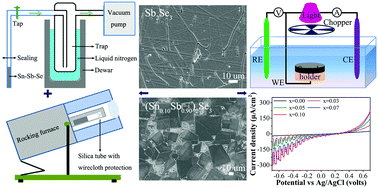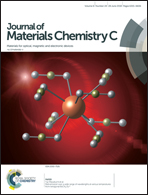Enhanced electrical conductivity and photoconductive properties of Sn-doped Sb2Se3 crystals†
Abstract
Sb2Se3 is a highly interesting semiconductor with high absorption coefficient in the visible range and is composed of non-toxic and earth-abundant elements. To overcome the challenge of intrinsic low electrical conductivity of Sb2Se3 crystals, tin-doped (SnxSb1−x)2Se3 semiconductors (x = 0.00, 0.03, 0.05, 0.07 and 0.10) have been synthesized by a conventional melt-quenching method in a vacuum sealed silica tube. With increasing Sn doping concentration, the (SnxSb1−x)2Se3 crystals exhibited a great improvement in electrical conductivity by several orders of magnitude thanks to the great increase of carrier concentration reaching almost 2 × 1016 cm−3. Compared to undoped Sb2Se3, the dark current density of a representative (Sn0.10Sb0.90)2Se3 increased by approximately 10 times and the photocurrent density with essentially visible illumination increased by approximately 14 times. In addition, the doped sample showed a faster, reversible and stable photoresponse. These excellent performances combined with a simple and easily scalable synthesis method pave the way for using this semiconductor for highly efficient photoelectric devices.



 Please wait while we load your content...
Please wait while we load your content...